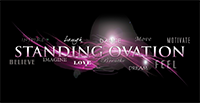Disciplines & Levels
Acro
A number that incorporates acrobatic elements throughout. All elements must be performed in a safe manner with appropriate spotters if necessary. (use years of gymnastics, jazz or acro, whichever is greater)
Classical Ballet
Contemporary
Contemporary is a style of expressive dance that combines elements of several dance genres. Contemporary dance places a strong emphasis on the connection between mind and body, with dancers being encouraged to explore their emotions through movement. (use years of contemporary or ballet – whichever is greater)
Contemporary Ballet
Demi Character / Character Ballet
Future Stars
Studios may choose to enter dancers aged 3–6 years into our Future Stars category. They will receive positive feedback from the Judges and will all be presented with a special Future Star medal during the onstage adjudication. The Judges will provide a written adjudication form – but will not apply a mark to it. Teachers will be allowed to assist the dancers on and off the stage as well as provide cuing in the wings or dance with them onstage.
*Please mark Future Stars in registration under notes. (use years of dance training)
Hip Hop
Improv
Interpretive
An interpretation of music, a mood, feeling or an idea that develops onstage. (use years of ballet or contemporary – whichever is greater)
Jazz
Lyrical
An expressive dance using the technical elements of ballet and jazz. It focuses on musicality and emotion through movement with an emotional commitment to the lyrics or song. (use years of lyrical or ballet – whichever is greater)
Modern
National
Open
Pointe
Any Classical, Demi Char Ballet or Contemporary Pointe number (please specify) where 51% or more of the dance is performed en pointe. *Due to the Encore Dance Offs, it is important to use years of ballet. This will place the dancers in the most appropriate level of training so that our senior dancers are not dancing with our beginner dancers in the Encore. (use years of ballet training)
Production
A Production must have 15 or more participants and must be between 5 and 10 minutes long. There must be at least one distinct change shown in the routine. (ie: music, costume, discipline, singing, etc.) Please fill out the age and years of training for all Productions. (use years of dance training)
Repertoire
Song and Dance
Student Choreography
Dancers must be Inter I – Semi-Pro to enter this category. It must be solely choreographed by theperformers themselves. Choreography notes do not need to be submitted. Can be entered in solo, duet, trio and group categories. (use years of dance training)
Tap
Variety
Any dance that has choreography that is different in nature from the other categories (ie: heels, cheerleading, free movement, lip syncing, etc.). It will be adjudicated for idea, choreography and entertainment value. (use years of dance training)
*Semi-Professional
Any number that includes Semi-Professionals and/or dancers that are 21 years or over must enter the Semi-Pro Category (or Adult Category – see below). All teachers of any age, (teaching 6+ hours per week) must also enter the Semi-Pro Category (may include former or current professional dancers). An exception to the rule would be older students entering a studio late, dancing in regular classes that are not Semi-Professional and dancing in the lower divisions of the competition. (please note: Semi-Pro numbers will be eligible for Encore Dance Offs if there are at least 6 numbers)
Levels
Leave all ages & levels to 2 decimal points. The current season counts as one year.
BEGINNER: All participants who are in their 1st year of dance training in the entered discipline. (no first solo rule – use yrs of training)
NOVICE: Where the years of dance training is between 2 and 3 years in the entered discipline.
JUNIOR: Where the years of dance training is between 4 and 5 years in the entered discipline.
INTER I: Where the years of dance training is between 6 and 7 years in the entered discipline.
INTER II: Where the years of dance training is between 8 and 9 years in the entered discipline.
ADVANCED: Where the years of dance training is between 10 and 12 years in the entered discipline.
ACCEL ADV: Where the years of dance training is 13 years and over in the entered discipline.
SEMI PRO: Semi Professionals, Teachers and dancers that are 21+ (see below for full details).
ADULT: Recreational Adult dancers.
BEGINNER: Where both participants are in their 1st year of dance training in the entered discipline.
NOVICE: Where the average years of dance training is between 2 and 3 years in the entered discipline.
JUNIOR: Where the average years of dance training is between 4 and 5 years in the entered discipline.
INTER I: Where the average years of dance training is between 6 and 7 years in the entered discipline.
INTER II: Where the average years of dance training is between 8 and 9 years in the entered discipline.
ADVANCED: Where the average years of dance training is between 10 and 12 years in the entered discipline.
ACCEL ADV: Where the average years of dance training is 13 years and over in the entered discipline.
SEMI PRO: Semi Professionals, Teachers and dancers that are 21+ (see below for full details).
ADULT: Recreational Adult dancers.
BEGINNER: Where 51% , or more, of the participants are in their first year of dance training in the entered discipline.
NOVICE to ADULT: Same rules as Duet Entries (see above).

